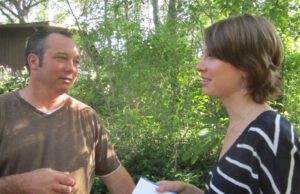Bethann is a Health Content Scientist at 23andMe and regular contributor to the Blog. The following is her story about finding out she has a genetic condition that puts her at risk for iron overload.

When I received my 23andMe results my initial reaction was that of relief and curiosity – only slightly increased risk for heart disease, heightened ability to taste bitter food, and slow metabolizer of caffeine. This all seemed reassuring and interesting until I discovered that I’d also inherited two mutations for hereditary hemochromatosis, also known as iron storage disease.
At first, I didn’t know what this meant for my health. My particular combination of mutations – one severe C282Y mutation in the HFE gene (a gift from my mother) combined with the much rarer and less severe S65C mutation (courtesy of my father) – only posed a slight risk for developing iron overload. And being a pre-menopausal woman lowered my risk profile even further because women naturally lose iron through menstruation.
Still, I decided to share the information with my physician to see if follow up testing was warranted. She ordered transferrin saturation and serum ferritin tests, which together provide a good picture of iron absorption and storage in the body, and the results revealed that my transferrin saturation was too high (54%). This result didn’t point to overload per se, but it did prompt me to take a step back and look at my lifestyle.
I’d been taking a daily multivitamin with iron for a few months – something I’d only sporadically done in my life – and I promptly stopped taking it. Knowing that I could be absorbing a lot of iron from my uncoated cast iron pan, a family heirloom used for generations in my husband’s family, I moved it to the back shelf. I also decided that it couldn’t hurt to cut back on iron-rich red meat and shellfish and to stop eating iron-fortified cereal for breakfast.
A few months later another iron panel was ordered and I was happy to see that my transferrin saturation had gone down to 25%, a very safe level (on both occasions my serum ferritin was in the normal range). But it wasn’t until I met with a hematologist that I gained a clear understanding of what my genetic results meant for my health.
When I tried to apologize to the hematologist for walking into his office “healthy”, he reassured me that I was doing the right thing and that prevention is key. We discussed my combination of mutations and he advised me to have my transferrin saturation and serum ferritin levels checked every two years. He also said that the game plan could change when I go through menopause and lose my natural way of expelling iron.
My hematologist also confirmed my decision to forgo iron supplementation and agreed that the cast iron pan was probably better off on the back shelf. He did think, however, that I should see how much control I have over the amount of iron I absorb through my diet and suggested that I begin eating some iron-rich food and then get another iron panel. I’m in my thirties and I’d prefer to know now whether my love for red meat and shellfish is out of the question or if moderate consumption is just fine.
It’s pretty clear that I don’t have much to worry about at the moment since simple lifestyle changes have pushed my iron markers into the healthy range. What has become obvious, though, is that my genetic predisposition for iron overload isn’t just about my health: it’s also about my family. I have two older brothers who could be at risk for hemochromatosis and I’m now in the process of getting them tested. There’s only a 25% chance that each of them also inherited these two mutations, but that’s not a chance that I want to take, especially since simple actions can make a world of difference for those at risk for iron overload.
July is National Hemochromatosis Month. Check out other posts on this condition:
– The Iron Scale: Factors Tipping Towards Overload
– Battling Against A Common Genetic Disease
– The Most Common Genetic Disease
![]()
View your results for more genetic factors linked to hemochromatosis in your account.
Not yet a customer? Visit our store!



